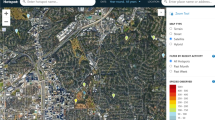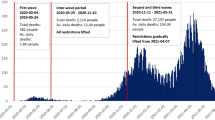Abstract
Urban landscapes are rapidly evolving, integrating diverse Points of Interest (POIs) to accommodate city dwellers’ needs, highlighting the necessity for efficient analytical frameworks. This study presents a preprocessing framework using KNIME, known for its user-friendly interface and robust data management, for efficient POI preprocessing. We integrated the Advan mobility dataset with the Census dataset, allowing us to consider both the POI features of the location and the characteristics of the people using these POIs. We also introduce two novel POI features that link visitors to POIs: median dwell time at POIs and visitor travel distance from home to POI, to deepen our understanding of POI dynamics. We used the framework to conduct spatiotemporal analyses across 31 POI categories, identifying significant temporal variations linked to daily human behaviour within these categories. For our spatial analysis case study, due to healthcare disparities across various geographic divisions in the US, we selected the outpatient care services category of POIs for deeper analysis. The study underscores a significant correlation between our two novel features and variances in both geographic (land area) and demographic (population density) aspects across nine US divisions. This research makes a substantial contribution to urban studies, providing a solid framework for POI analysis and introducing other influential features along with visitors’ check-in data for examining POIs in cities.
Access this chapter
Tax calculation will be finalised at checkout
Purchases are for personal use only
Similar content being viewed by others
References
Agnew, J.A., Shelley, F.M., Pringle, D.G.: Agnew, J.A.: 1987: place and politics: the geographical mediation of state and society. Prog. Human Geogr. 27(5), 605–614 (2003)
Barbosa, H., et al.: Human mobility: models and applications. Phys. Rep. 734, 1–74 (2018)
Berthold, M.R., et al.: KNIME-the Konstanz information miner: version 2.0 and beyond. ACM SIGKDD Explor. Newsl. 11(1), 26–31 (2009)
Betancourt, F., Riascos, A.P., Mateos, J.L.: Temporal visitation patterns of points of interest in cities on a planetary scale: a network science and machine learning approach. Sci. Rep. 13(1), 4890 (2023)
Chang, T., Hu, Y., Taylor, D., Quigley, B.M.: The role of alcohol outlet visits derived from mobile phone location data in enhancing domestic violence prediction at the neighborhood level. Health Place 73, 102736 (2022)
Cyr, M.E., Etchin, A.G., Guthrie, B.J., Benneyan, J.C.: Access to specialty healthcare in urban versus rural us populations: a systematic literature review. BMC Health Serv. Res. 19(1), 1–17 (2019)
Di Martino, S., Mazzocca, N., Di Torrepadula, F.R., Starace, L.L.L.: Mobility data analytics with KNOT: the KNime mObility Toolkit. In: Mostafavi, M.A., Del Mondo, G. (eds.) Web and Wireless Geographical Information Systems. W2GIS 2023, LNCS, vol. 13912, pp 95–104. Springer, Cham (2023). https://doi.org/10.1007/978-3-031-34612-5_6
Du, Z., Zhang, X., Li, W., Zhang, F., Liu, R.: A multi-modal transportation data-driven approach to identify urban functional zones: an exploration based on hangzhou city, china. Trans. GIS 24(1), 123–141 (2020)
Fillbrunn, A., Dietz, C., Pfeuffer, J., Rahn, R., Landrum, G.A., Berthold, M.R.: Knime for reproducible cross-domain analysis of life science data. J. Biotechnol. 261, 149–156 (2017)
Giannopoulos, G., Alexis, K., Kostagiolas, N., Skoutas, D.: Classifying points of interest with minimum metadata. In: Proceedings of the 3rd ACM SIGSPATIAL International Workshop on Location-based Recommendations, Geosocial Networks and Geoadvertising, pp. 1–4 (2019)
Hu, Y., Quigley, B.M., Taylor, D.: Human mobility data and machine learning reveal geographic differences in alcohol sales and alcohol outlet visits across us states during covid-19. PLoS ONE 16(12), e0255757 (2021)
Jay, J., Heykoop, F., Hwang, L., de Jong, J., Kondo, M.: Effects of the covid-19 pandemic on park use in us cities. medRxiv, pp. 2021–04 (2021)
Jenkins, P., Farag, A., Wang, S., Li, Z.: Unsupervised representation learning of spatial data via multimodal embedding. In: Proceedings of the 28th ACM International Conference on Information and Knowledge Management, CIKM 2019, pp. 1993-2002. Association for Computing Machinery, New York, NY, USA (2019). https://doi.org/10.1145/3357384.3358001, https://doi.org/10.1145/3357384.3358001
Kirby, J.B., Yabroff, K.R.: Rural-urban differences in access to primary care: beyond the usual source of care provider. Am. J. Prev. Med. 58(1), 89–96 (2020)
Lagos, N., Ait-Mokhtar, S., Calapodescu, I.: Point-of-interest semantic tag completion in a global crowdsourced search-and-discovery database. In: ECAI 2020, pp. 2993–3000. IOS Press (2020)
Lai, S., Farnham, A., Ruktanonchai, N.W., Tatem, A.J.: Measuring mobility, disease connectivity and individual risk: a review of using mobile phone data and mhealth for travel medicine. J. Travel Med. 26(3), taz019 (2019)
Lefevre, S., Tuia, D., Wegner, J.D., Produit, T., Nassar, A.S.: Toward seamless multiview scene analysis from satellite to street level. Proc. IEEE 105(10), 1884–1899 (2017)
Liang, Y., Yin, J., Pan, B., Lin, M.S., Miller, L., Taff, B.D., Chi, G.: Assessing the validity of mobile device data for estimating visitor demographics and visitation patterns in yellowstone national park. J. Environ. Manage. 317, 115410 (2022)
Liu, B., Deng, Y., Li, M., Yang, J., Liu, T.: Classification schemes and identification methods for urban functional zone: a review of recent papers. Appl. Sci. 11(21), 9968 (2021)
Maláková, K.: A geodemographic view of the accessibility of selected outpatient services in czechia. Int. J. Public Health 67, 1604067 (2022)
McKenzie, G., Janowicz, K., Gao, S., Gong, L.: How where is when? on the regional variability and resolution of geosocial temporal signatures for points of interest. Comput. Environ. Urban Syst. 54, 336–346 (2015)
Milias, V., Psyllidis, A.: Assessing the influence of point-of-interest features on the classification of place categories. Comput. Environ. Urban Syst. 86, 101597 (2021)
Psyllidis, A., et al.: Points of interest (poi): a commentary on the state of the art, challenges, and prospects for the future. Comput. Urban Sci. 2(1), 20 (2022)
Seamon, D.: Body-subject, time-space routines, and place-ballets. Hum. Exp. Space Place 148, 65 (1980)
Srivastava, S., Vargas Munoz, J.E., Lobry, S., Tuia, D.: Fine-grained landuse characterization using ground-based pictures: a deep learning solution based on globally available data. Int. J. Geogr. Inf. Sci. 34(6), 1117–1136 (2020)
Sun, Y., et al.: GEDIT: geographic-enhanced and dependency-guided tagging for joint poi and accessibility extraction at baidu maps. In: Proceedings of the 30th ACM International Conference on Information & Knowledge Management, pp. 4135–4144 (2021)
Talukdar, S., Singha, P., Mahato, S., Pal, S., Liou, Y.A., Rahman, A., et al.: Land-use land-cover classification by machine learning classifiers for satellite observations—a review. Remote Sens. 12(7), 1135 (2020)
Wang, J., Kong, X., Xia, F., Sun, L.: Urban human mobility: Data-driven modeling and prediction. ACM SIGKDD Explor. Newsl 21(1), 1–19 (2019)
Zarbakhsh, N., McArdle, G.: Points-of-interest from mapillary street-level imagery: a dataset for neighborhood analytics. In: 2023 IEEE 39th International Conference on Data Engineering Workshops (ICDEW), pp. 154–161. IEEE (2023)
Zarbakhsh, N., Misaghian, M.S., Mcardle, G.: Human mobility-based features to analyse the impact of covid-19 on power system operation of Ireland. IEEE Open Access J. Power Energy 9, 213–225 (2022)
Zhang, F., et al.: Uncovering inconspicuous places using social media check-ins and street view images. Comput. Environ. Urban Syst. 81, 101478 (2020)
Zhou, J., et al.: A collaborative learning framework to tag refinement for points of interest. In: Proceedings of the 25th ACM SIGKDD International Conference on Knowledge Discovery & Data Mining, pp. 1752–1761 (2019)
Zhu, Y., Deng, X., Newsam, S.: Fine-grained land use classification at the city scale using ground-level images. IEEE Trans. Multimedia 21(7), 1825–1838 (2019)
Ziller, E., Milkowski, C.: A century later: rural public health’s enduring challenges and opportunities. Am. J. Public Health 110(11), 1678–1686 (2020)
Author information
Authors and Affiliations
Corresponding author
Editor information
Editors and Affiliations
Ethics declarations
Framework Availability
The Novel POI Spatiotemporal Framework is publicly available for use and can be accessed at https://github.com/NeginZarbakhsh/Novel-POI-Spatiotemporal-Framework-By-Dwell-Time-and-Travel-Distance.git.
Rights and permissions
Copyright information
© 2024 The Author(s), under exclusive license to Springer Nature Switzerland AG
About this paper
Cite this paper
Zarbakhsh, N., McArdle, G. (2024). A Novel Framework for Spatiotemporal POI Analysis. In: Lotfian, M., Starace, L.L.L. (eds) Web and Wireless Geographical Information Systems. W2GIS 2024. Lecture Notes in Computer Science, vol 14673. Springer, Cham. https://doi.org/10.1007/978-3-031-60796-7_2
Download citation
DOI: https://doi.org/10.1007/978-3-031-60796-7_2
Published:
Publisher Name: Springer, Cham
Print ISBN: 978-3-031-60795-0
Online ISBN: 978-3-031-60796-7
eBook Packages: Computer ScienceComputer Science (R0)




